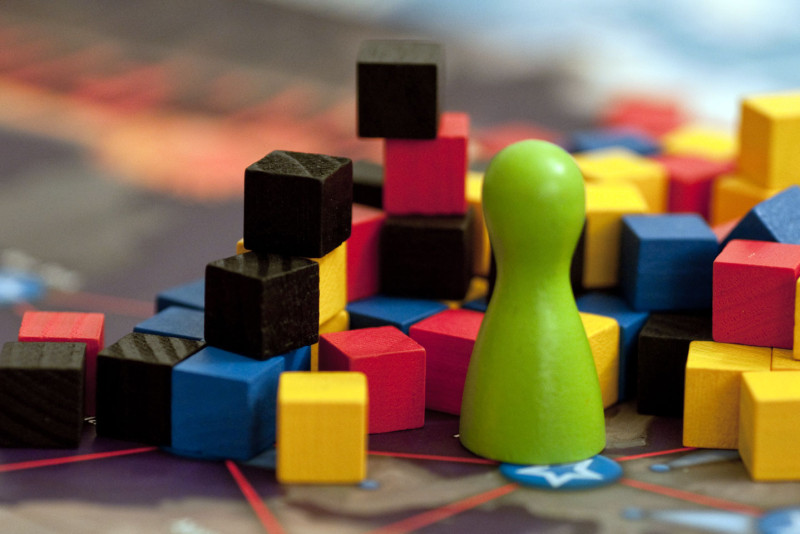There are several games in the Pandemic universe. The dice version, Pandemic: The Cure, sets up in minutes, making it logistically easy to integrate into a class lesson. There is no board; rather, there are six tiles, each representing a major region of the world.
PLAGUE, INC.
Playing as a pathogen presents a different viewpoint for learning. Plague, Inc. is an app game in which players get to take on that role, playing as bacteria, virus and other contagions. “The world is your Petri dish, and you are in there, tweaking the variables,” said creator, James Vaughan. “It makes people look at the whole issue of infectious disease in a way they wouldn’t ordinarily do.”
Vaughan’s background as an economist has played a role in the game’s ultimate design. Plague, Inc. makes a game out of the world’s interconnected infrastructure systems, similar to other “fishbowl” games, like SimCity. “A lot of economics is about reducing the world down into certain models,” he said. “Then you make assumptions and adjust the models. You see the impact and then try to predict how things might work in the future.”
Upon first playing Plague, Inc., it is tempting to “power-up” the genetic makeup of the pathogen to be as lethal as possible. Doing so, however, can result in failure because if all of the human hosts are killed, the disease dies out. “It brings people to well-known concepts about infectious disease, but in a very different route,” Vaughan said. To succeed, players must take into account global health care systems and interconnected travel networks (airlines, shipping lanes), as well as the economies of developing nations.
Rather than points and badges, player performance is tracked in real-time with graphs and charts. “I wanted to see how the data in the model was changing over time,” Vaughan explained. “The graphs were something helpful when I was initially creating and balancing the model. It turned out that it was also something that players found interesting. The concept of infectious diseases is that of exponential growth. You really have to look at the graph to grasp the consequences of that.” Here, students are presented with an opportunity to work with data in a way that is meaningful and embedded to an experience.
POX
The reward mechanisms and intrinsic engagement that games offer can, theoretically, be used to teach the public about health concerns, such as the benefits of getting vaccinated from communicable diseases (especially amidst the re-emergence of measles in the U.S.). One example is Pox: Save the People, from the Tiltfactor studio at Dartmouth University. It is a cooperative board game (also playable for free on iPad) in which “vaccinated” blue chips must surround “infected” red poker chips. Its core mechanic delivers this message: vaccination circles protect society from cured diseases, like polio, measles and small pox.
ASSESSING LEARNING
Authentic assessments, using open-ended questions and rubrics, can effectively gauge student learning with health-themed games. For example, players of Pox can be asked how—and why—vaccination circles work. Pandemic and Plague, Inc. players can write diary and journal notes during play. What’s more, there are historic parallels to how the small pox affected Native Americans, as well as how the plague traveled along the Silk Road to medieval Europe. Connections can also be made to modern epidemics, too: from Ebola to the measles.
Pandemic has expansion packs with additional role cards and scenarios, including bioterrorist attacks. Because it is a paper-based, students can easily modify (“mod”) their learning by making different versions of roles and situations. For digital learners, Plague, Inc. Evolved (the PC and Mac version) features the Contagious Content Creator, which turns players into designers, affording an opportunity to work within Vaughan’s model. So far, the community has recreated historic plagues, like small pox and Spanish influenza, as well as modeled how infectious ideas—like democracy—spread. In 2014, there was a Christmas-themed epidemic, in which happiness spread worldwide.
REAL WORLD CONNECTIONS
When fears of Ebola in the United States rose in the fall of 2014, so did downloads of Plague, Inc. Vaughan harnessed his player community to raise $76,000. He said, “[People] don’t always realize how a community of gamers can come together as a force for good.” Similarly, in December 2014, “Pandemic Parties” raised money and awareness for Doctors Without Borders, the international organization working to treat Ebola in West African nations. As of February 2015, Pandemic Parties collectively raised over $50,000.
In 2013, the Center for Disease Control (CDC) invited Vaughan to speak about public health issues. (The CDC is headquartered in Atlanta, GA, where play begins on the Pandemic game board.) While there, Vaughan had the opportunity to speak to experts about how to use games to increase public awareness of certain health issues. “Plague Inc. isn’t going to teach someone everything they need to know about infectious diseases,” Vaughan explained. “However, it will get people thinking about disease. That’s something the CDC has tried with the public, like with its Zombie Preparedness Kit. It’s impactful because it turns people on their heads a bit.”


